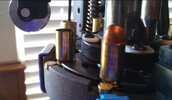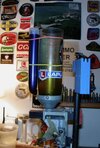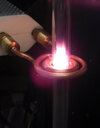I've only got 23 years on Dillon powder measures, but my experience is the exact same. Properly setup, there is zero variation in powder "drops".
I believe our friend
Ky Dan will spend a lot of time and money on the fixed volume powder slide idea and then discover the problem is not the Powder Bar at all. I note that there are 2 primary setup details that are not mentioned at all...
1) He started with a new can of Bullseye, but I can't find where he told us
how full the powder hopper was filled.
2) During setup, we were not told how many powder "drops" were made before loading began. Like all mechanical powder measures, the powder is measured by
Volume. However what we want is
Weight. The
ONLY aspect that joins consistent
volume to consistent
weight is consistent
Density. If your powder measure isn't allowed to settle to a consistent density
before loading begins then, yes, your results during loading will wander. This is basic
Powder Measure 101, but I'm always surprised how many reloaders still don't know this. By allowing the powder measure to drop around 10 loads BEFORE loading begins, the shaking of the Dillon PM should settle the powder inside to the highly desired consistent density.
Dillon users can make the shaking more consistent and therefore achieve more accurate powder drops by adding a light return pressure to the Powder Bar. This can easily be done with rubber bands or a Dillon 450 return spring that has been "lightened up". Photos below...








